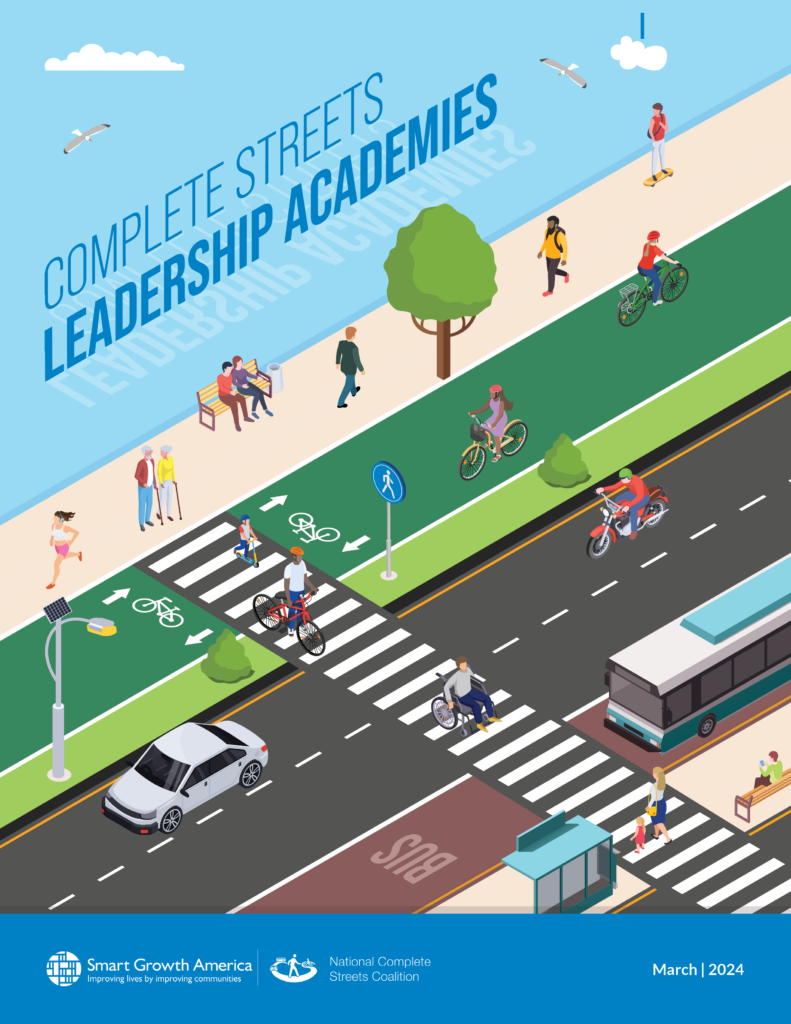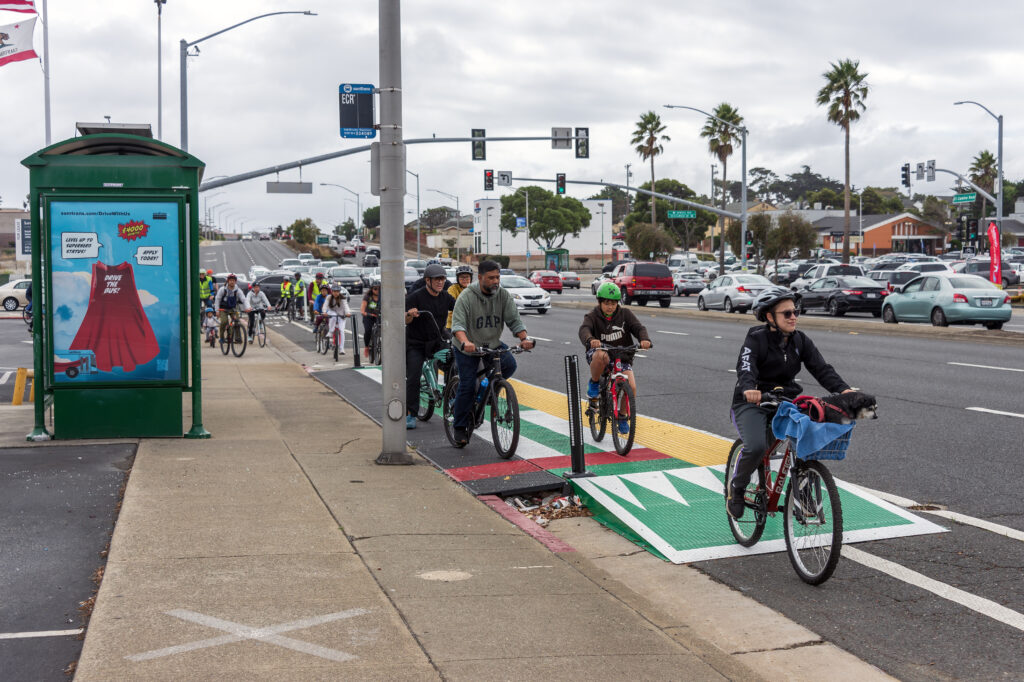The City of San Leandro’s project was unique as they chose to demonstrate a small portion of an already approved county-led bike-lane project. The city leveraged this opportunity to host a pop-up event to unveil an art installation, build better partnerships, and engage the community on its plans and vision. Read the full case study in the Complete Streets Leadership Academies Report and explore the other case studies here.
Project Snapshot
San Leandro selected East 14th Street (State Route 185) from Hesperian Blvd to 150th Avenue for the quick-build demonstration site. The team utilized a city-owned striping paint machine and stencil to create a protected bike lane further supported by flex post delineators and adhesive pads to create the physical separation. The San Leandro cohort selected this street because it connects residents to regional transportation facilities, employment areas, and activity centers but is a dangerous corridor in need of improvement: about 90 percent of the corridor is identified as part of the countywide high-injury pedestrian network and 50 percent of the corridor is part of the high-injury bicycle network.
East 14th Street is part of an upcoming East Bay Greenway project which is a regional trail project spanning multiple cities to improve pedestrian and cyclist connections along the BART corridor. This includes a separated bike lane on East 14th Street, providing a vertical barrier between the bike lane and moving traffic, as well as transit boarding islands along a portion of the corridor. Unlike other projects in the academy where cities choose to test out new project ideas (which are not already a part of an approved project plan), San Leandro decided to use this opportunity to demonstrate a small portion of the already designed, approved, and upcoming bike lane to gather additional data and community input.
As part of the quick-build demonstration project, the city hosted a pop-up event in June 2023 on the Hesperian Triangle, often referred to as “the Triangle,” to share more information about the upcoming changes to the corridor and encourage community members to try out the bike lane and provide feedback. The event was also the opening of a new art installation in the Triangle called “Genie Bottle,” in addition to an existing art installation called the “Purr Pods.” Approximately 70-100 people attended the one-day event which had live music, food, and stalls from other community partners such as Bike East Bay.
Outcomes
While photos, videos, and media coverage demonstrated a successful launch event and engagement on the project site, San Leandro did not collect or report any formal outcomes from the experience. Collecting data such as the number of users, their experience with the temporary bike lane, or feedback from surrounding businesses would have strengthened the case made by the quick-build project.
Key Takeaways
Be aware of any conflicting and overlapping project timelines when a corridor is within the jurisdiction of multiple agencies. The City of San Leandro planned their eight-week demonstration project timeline strategically so that the removal could take place in advance of a Caltrans repaving project on the same corridor. This would’ve been a challenge if city and Caltrans officials hadn’t communicated and coordinated on the project timeline and schedules before project implementation. Alternatively, in cases where timelines overlap, there may be opportunities to collate resources which could be beneficial for all partners involved.
Take weather into account when selecting temporary materials. In addition to the permanent art installations already cited on the Hesperian Triangle, the city installed a temporary interactive art installation which was destroyed by high winds. Taking local weather conditions into account is crucial when selecting materials for pop-up installations.
Starting small can be a good first step to build momentum. San Leandro utilized this opportunity to engage the community through a demonstration of a short stretch of an already approved project and received a great response. Smaller-scale projects such as this one can be a good way to build internal and external momentum when a city is trying a new approach like quick builds on state-owned roads, but the city does not capitalize on the momentum quickly. Subsequent tests of more creative ideas to improve safety on city streets should be planned to help move toward successive implementation as soon as possible.
Data collection is key to making your case. San Leandro chose to not collect any formal feedback around the project including at the pop-up event. Collecting data would have provided important opportunities for community engagement and input. Data collected could have been used in determining next steps and demonstrating the impact of the project for future planning.
 In 2022, Smart Growth America launched the Complete Streets Leadership Academies in Alaska, California, Connecticut, and Tennessee to equip and train local agencies and state departments of transportation to collaborate, innovate, and commit to making changes together to address safety on these dangerous state-owned roads. Cohorts were selected to plan and implement “quick-build” demonstration projects, a way to pilot and test new ideas and street designs to activate streets and better support walking, biking, and rolling.
In 2022, Smart Growth America launched the Complete Streets Leadership Academies in Alaska, California, Connecticut, and Tennessee to equip and train local agencies and state departments of transportation to collaborate, innovate, and commit to making changes together to address safety on these dangerous state-owned roads. Cohorts were selected to plan and implement “quick-build” demonstration projects, a way to pilot and test new ideas and street designs to activate streets and better support walking, biking, and rolling.This program and report was developed with funding from the Centers for Disease Control and Prevention’s (CDC) Division of Nutrition, Physical Activity, and Obesity (Cooperative Agreement CDC-RFA-OT18-1802). The views presented in this product do not necessarily reflect the views and/or positions of CDC.
